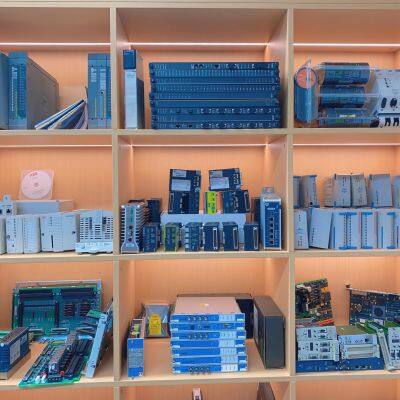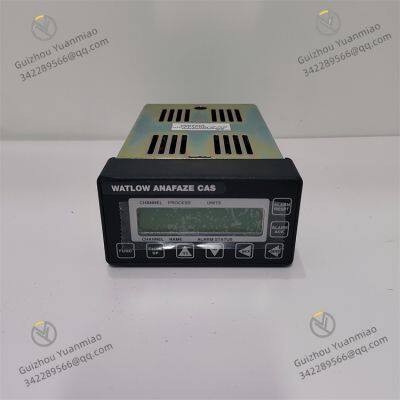Product Description
I. Overview
WATLOW ANAFAZE CAS 16CLS/CAS, as an industrial device with excellent functions, performs prominently in the field of temperature control and related industrial applications. It integrates advanced technology and precision manufacturing processes, and is specially designed to meet the stringent requirements for precise control in complex industrial environments. With stable and reliable performance, flexible and diverse functions, and a compact and reasonable design, CAS 16CLS/CAS is widely used in many industries. It has become a powerful assistant in realizing efficient and precise industrial production processes, providing solid support for enterprises to improve production efficiency and ensure product quality.

II. Technical Parameters
Power parameters: It supports a wide voltage input range of 100-240V AC. This design enables it to adapt to the power supply conditions of different regions and industrial sites, reduce the impact of voltage fluctuations or differences in power supply standards on the operation of the device, ensure stable operation in various complex power grid environments, and provide reliable power guarantee for the continuous operation of the device.
Control type: It adopts the advanced PID (Proportional-Integral-Derivative) control algorithm. The PID control algorithm can accurately adjust the output signal through proportional, integral, and derivative operations according to the deviation between the set temperature and the actual measured temperature, thereby achieving precise control of temperature. This algorithm has the advantages of fast response speed, high control precision, and strong stability, which can effectively suppress temperature fluctuations, ensure that the temperature of the controlled object is stable near the set value, and meet the strict requirements of industrial production for temperature control precision.
Output type: It is equipped with SSR (Solid State Relay) output. Solid state relays have the characteristics of no contacts, fast switching speed, long service life, and strong anti-interference ability. Compared with traditional electromagnetic relays, SSR can significantly improve the reliability and stability of the device in working scenarios with frequent start and stop, and reduce maintenance costs. At the same time, its fast switching response speed can better cooperate with the PID control algorithm to achieve precise control of heating or cooling equipment, ensuring the timeliness and accuracy of temperature regulation.
Temperature range: It has an extremely wide temperature control range from -200°C to 1000°C. This wide temperature range makes it suitable for industrial applications in various extreme temperature environments. Whether it is ultra-low temperature refrigeration and freezing processes, or high-temperature heat treatment and smelting processes, CLS208 can be competent, which greatly expands the application field of the device.
Accuracy: The temperature control accuracy can reach ±0.1°C. Such high accuracy can meet the industrial production processes that are extremely sensitive to temperature changes, such as semiconductor manufacturing and precision chemical synthesis. In these industries, small temperature deviations may have a significant impact on product quality, and the high-precision characteristic of CAS 16CLS/CAS provides a strong guarantee for the production of high-quality products.
Dimension specifications: It adopts a compact 1/8 DIN package design with small overall dimensions. This compact structural design enables it to be easily installed inside industrial control cabinets, equipment enclosures, etc. with limited space, saving valuable installation space. It is especially suitable for scenarios such as small automated production lines and field control units in distributed control systems that have high requirements for equipment space layout.

III. Functional Features
Powerful temperature control capability: Based on the advanced PID control algorithm and high-precision temperature sensor, CAS 16CLS/CAS can accurately adjust and stably control the temperature. It can excellently complete tasks whether it is simple constant temperature control or complex temperature curve tracking control. For example, in laboratory equipment, it can accurately set and maintain a specific temperature environment according to experimental needs, providing reliable experimental conditions for scientific research; in the food processing industry, it can precisely control the temperature of baking, cooking and other processes to ensure the taste and quality consistency of food.
Flexible input and output configuration: It supports various types of sensor inputs, including thermocouples, resistance temperature detectors (RTD), linear voltage, current, and frequency. This diversified input mode enables CAS 16CLS/CAS to be used with various types of temperature detection components, meeting the actual needs of different industrial sites. At the same time, the rich output interfaces can be conveniently connected to various actuators, such as heating wires and refrigeration compressors, to achieve effective temperature regulation. In addition, the device is also equipped with multiple digital output ports, which can be used to control auxiliary equipment such as alarm devices and indicator lights, providing more comprehensive control and status indication functions for the system.
Convenient operation and monitoring: It is equipped with an intuitive menu-guided operation interface and a full-text display screen. Operators can easily complete operations such as parameter setting and operation mode selection of the device through simple key operations without complex training. The full-text display screen can clearly show the operation status of the device, current temperature value, set temperature value, and various alarm information, facilitating operators to monitor the operation of the device in real-time. In addition, the device also has built-in serial communication interfaces (such as EIA/TIA-232 and 485), which can realize remote operation, data collection, and monitoring functions by connecting to a computer or other upper computer control systems, facilitating centralized management and automated control of the production process.
Fault diagnosis and protection functions: It has perfect fault diagnosis and protection mechanisms. It can monitor the working status of the sensor in real-time, timely detect and report sensor faults, such as sensor open circuit, short circuit, signal abnormality, etc., effectively reducing inaccurate temperature control or production accidents caused by sensor faults. At the same time, the device is also equipped with various protection functions such as over-temperature, over-current, and under-voltage. When abnormal conditions are detected, it can immediately take corresponding protection measures, such as cutting off the output power, to prevent damage to the device and the production process, and ensure production safety and device reliability.

IV. Common Faults and Solutions
Inaccurate temperature control
Possible causes: Sensor faults, such as aging, damage, or improper installation position, leading to inaccurate temperature detection; unreasonable PID parameter settings that cannot adapt to the characteristics of the actual controlled object; faults in heating or cooling equipment, such as aging of heating wires, reduced efficiency of refrigeration compressors, etc., affecting the temperature regulation effect; environmental interference, such as the presence of strong electromagnetic fields, poor ventilation, etc., interfering with the temperature sensor or the control signal of the device.
Solutions: Check the working status of the sensor. A standard thermometer can be used to calibrate and test the sensor. If the sensor is damaged or aged, replace it with a new one in time, and ensure that its installation position is correct and can accurately measure the temperature of the controlled object. According to the characteristics and operation of the actual controlled object, readjust the PID parameters. The optimal PID parameter combination can be found through the auto-tuning function (if the device has it) or manual debugging. Check the heating or cooling equipment, such as replacing aging heating wires, repairing or replacing refrigeration compressors, etc., to ensure their normal operation. Investigate environmental interference factors and take corresponding shielding and isolation measures, such as electromagnetic shielding of the device and improving ventilation conditions, to reduce the impact of environmental factors on the device.
Device cannot start
Possible causes: Power supply faults, such as loose power cords, damaged power modules, abnormal power supply voltage, etc.; internal circuit faults of the device, such as blown fuses, short circuits or open circuits of the circuit board, etc.; controller program faults, such as program loss, damage, or crash.
Solutions: Check whether the power cord connection is firm, use a multimeter to measure the power output voltage, and judge whether the power module is working normally. If the power module is damaged, it is necessary to replace it with a suitable one. Open the device shell, check the internal circuit, and see if the fuse is blown. If it is blown, replace it with a fuse of the same specification; carefully check the lines on the circuit board to find out if there is a short circuit or open circuit. If there is a problem, repair it with welding tools or replace the damaged circuit board. For controller program faults, try to reset the device (if the device has a reset function). If the problem cannot be solved after resetting, contact WATLOW's technical support personnel to obtain the corresponding program repair or upgrade plan, and reinstall the controller program through an external storage device (such as a USB flash drive).

Communication connection failure
Possible causes: Damaged communication cables, loose interfaces; incorrect communication parameter settings, such as baud rate, data bits, stop bits, parity bits, etc., which do not match the upper computer or other devices; faults in the device's communication module.
Solutions: Check whether the communication cable is damaged or broken, and whether the interface is tightly plugged. If there is a problem, replace the cable or re-plug the interface in time. Enter the communication setting interface of the device, carefully check the communication parameters to ensure that they are consistent with those of the upper computer or other devices communicating with it. If the communication parameters are set correctly but communication still cannot be achieved, there may be a fault in the device's communication module. It is necessary to contact professional maintenance personnel to detect and repair the communication module, such as replacing the damaged communication chip and repairing the communication circuit.
Frequent alarms
Possible causes: Sensor faults leading to abnormal temperature alarms; device operating parameters exceeding the set alarm thresholds, such as over-temperature, over-current, under-voltage, etc.; overly sensitive alarm settings, and the actual operating conditions do not reach the real fault state.
Solutions: According to the sensor inspection method in the inaccurate temperature control fault, check for sensor faults and repair or replace them. Check the operating parameters of the device, such as temperature, current, voltage, etc., to determine whether they really exceed the normal working range. If the parameter abnormality is caused by device faults, it is necessary to repair or replace the corresponding device components. Re-evaluate the alarm setting thresholds, and reasonably adjust the alarm sensitivity according to the actual operation of the device and safety requirements to avoid frequent false alarms caused by improper alarm settings.


TEAM BL0308 Expansion Module
MKS T3BIB-29916 Valve DeviceNet Interface
STEC S83-1003-01 Controller Module
SCHROFF MPS022 DC Power Supply Module
SBS VIPC616 91611524 4-slot 6U VME IndustryPack Carrier
SAT CM3141-02-03 Proximitor Seismic Monitor
SAT CM3142-01-03 Proximitor Seismic Monitor
SAT RM3141-01-02 Proximitor Seismic Monitor
RAMIX PMC008A 700502 PMC to Mezzanine Adapter
RAMIX PMC237C-008EMI Expansion Module
TeIKOOR PSMU-350-3 CPCIAC-6U-500 900-7002-10 Power Supply Module
METSO DPU-MR Processing Unit
 yezi
Hi there! Welcome to my shop. Let me know if you have any questions.
yezi
Hi there! Welcome to my shop. Let me know if you have any questions.






